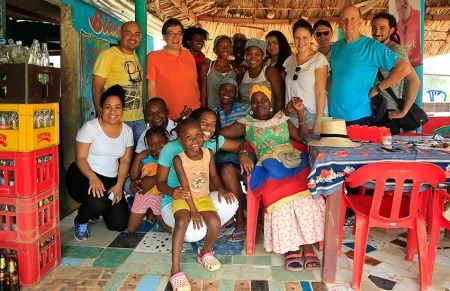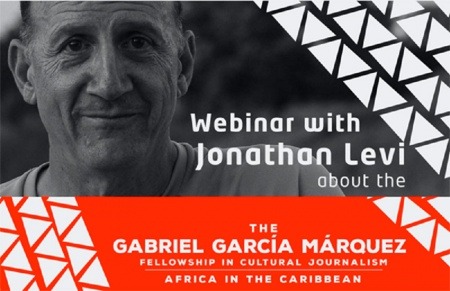A young man approaches the backyard porch where hanging clothes dry in the sun. His white shirt and red cross in the bag states a conviction: the disease inhabits the house. She is there to administer vaccines, explains to a relapse woman in a chair. There is no answer, just a mumble inaudibly, disbelieving. In front of her, another old and squalid lady lays entertained with wisps of her ragged dress. Without annoyance or compassion, the nurse pulls a chair, scribbles notes and offers ampoules as if she was selling encyclopedias.
In a settlement in Colombia, founded by escaped slaves three centuries ago, Alexandre Moniz finds that while the iron shackles have been broken, the residents remain chained to the past by a desire to maintain the history for posterity.
The story of Goa’s St Francis Xavier can be rivaled by that of Colombia’s San Pedro Claver. Both were Jesuits from Spain, missionaries, and their mortal remains preserved in Goa and Cartagena, Colombia respectively. Alexandre Moniz visits Cartagena to find that the similarities are uncanny but the veneration of the saints is far different.
Gabriel García Márquez Fellowship in Cultural Journalism took place in Cartagena de Indias and San Basilio de Palenque, from August 29 to September 3, 2016. They were six days of intense work in which 15 journalists selected, along with masters, Hector Feliciano, Jonathan Levi, Ellah Wakatama Allfrey and Luis Rafael Sánchez shared, learned and worked around the craft of writing, the importance of tradition and African culture in the construction of identity in the Caribbean and the role of journalists putting on public discussion African issues.
In 2016 the workshop explores the contributions of the local population of African origin in the culture of the Caribbean, particularly Cartagena de Indias and the nearby San Basilio de Palenque; using the tools of cultural journalism including interviews, reporting, and personal commentary. It is also an opportunity to think about the role of cultural journalism in an era in which creator and audience have an increasingly direct contact, facilitated by digital tools.
Levi, one of the directing teachers of the fellowship, will answer questions from interested applicants about the work fellows will be doing, the role teachers play and application requirements live in English.
Filigree is a delicate kind of jewelry metalwork, usually of gold or silver, made with twisted threads and tiny beads in combination arranged in artistic motifs. The technique was originally brought to Mompox by Spanish colonists, and many families have practiced it for generations. There are dozens of artisan workshops in Mompox producing and selling exquisite hand-made earrings, bracelets, and other knick-knacks for prices varying as low as 15,000 pesos (~$5) and up to $200 depending on the complexity and weight of the item.
Where do perfectly happy momposinos get their rocking chairs from? In Mompox there are probably 20 carpenter’s workshops. And the business is going well: workshop owners sell the chairs to momposinos, to residents of other towns (e.g. Baranquilla) and to the tourists who come here from all the parts of Colombia. In the workshop where I meet Hernan, they make 200 chairs per month. And they sell them all out easily.
The horse-drawn carriages are the icon of Cartagena. First, it was a way of transport strongly related to the people of power, e.g. the members of the inquisition; it also became popular among the wealthy residents of the city. As time went by, carriages became more and more democratic: first as middle-class people’s mode of transportation and then, finally, since 1945, as a tourist attraction. Which is lately considered to be a controversial one.
The only mosque in Cartagena is situated somewhere that even many locals residing here for so many years couldn’t identify on a map or had never heard of. After swinging between the idea of going to Sector Marlinda Calle Segunda in La Boquilla where the mosque was supposedly located, and not opting to go because nobody was sure if a mosque were there at all, we eventually hit the road and took a taxi to go to the place which eventually turned out to be a wonderland.
The district is undergoing gentrification so that it can function as a more well-liked tourist haunt, but the architectural pattern is still preserved and the colonial legacy is silently there. However, you don’t find so many cathedrals or museums in Getsemaní, enchantingly present everywhere in the city, underlining, as many of my local friends told me, the piety and strong religious integrity of the people in Latin America.
Mompox, officially Santa Cruz de Mompox, sits on an island with the Magdalena River, Colombia’s famous river flowing gracefully at its feet. Once Colombia’s mineral vault, Mompox continues to represent a living exhibition of colonial architecture that has been jealously preserved over time. It doesn’t, however, come as any surprise it earned a UNESCO world heritage status.
Two teenage boys rap to a table of tourists. They take turns rhyming and passing a small toy boat between them. It’s their speaker, loaded with beats off of the internet. They slice the air with it as they punch their lyrics with heavy gestures, their shoulders bouncing, knees dipping. Patrons perturbed dart annoyed glances over their mojitos. But these boys are good.






